RIGHT TURN ONLY!!
Oh My Rain Goddess!
by Carlo Santos,

Comic-Con is nearly upon us. I can't even begin to imagine the teeming masses that will be clamoring at the doors of Hall H on Friday to get a once-in-a-lifetime glimpse of Hayao Miyazaki.
Then again ... I wouldn't mind if it were Miho Miyazaki!

Not a legendary Japanese animator.
AMEFURASHI: THE RAIN GODDESS

Vol. 1
(by Atsushi Suzumi, Del Rey, $10.99)
FROM THE BACK COVER:
"Gimmy is just an ordinary teen living in a desert town when his younger twin brother and sister disappear. While searching for them, Gimmy comes face-to-face with a sassy deity, Sora, the rain goddess who provides water to the town. But another goddess, Ciel, wants Sora's sacred tree—so that she can control the rain!"
EVIDENCE FOR:
There's something of a magical folk-tale quality to Amefurashi, with its central imagery being that of a giant life-giving tree and the small desert town that relies on its enchanted presence. Once our hero Gimmy finds himself among the tree's branches and starts getting into all sorts of trouble with Sora, that's when the creativity really takes off: get ready for sights like a house suspended thousands of feet above the ground, rain falling upside-down (which is why you should never irritate a rain goddess), and a magical water bubble that transports people from the sky to the ground. At the same time, though, there's also a charismatic, down-to-earth quality to Sora, with her casual looks and a wide-eyed approach to life. What could be more appealing than a deity that is divine yet also approachable? The high page count and action-packed layouts also allow each chapter to develop fully—after a number of lively comedic adventures, things take a much more serious turn when Ciel shows up. Although fun and lighthearted in some places, this series also has a real story to tell.
EVIDENCE AGAINST:
A high page count can also expose the weaknesses of storytellers who don't know what they're doing—and that seems to be what's happening here, as the clever imagery in the first couple of chapters gradually gives way to much more pedestrian material like "bad guys kidnap Sora" and "Sora runs out of magical power." That's the kind of stuff that could happen to any deity or spirit, so where's all the cool phenomena that directly involves rain? And because these chapters run into 30+ page territory, the pacing gets bogged down by extra-padding scenes where nothing actually gets accomplished. Like the characters chatting amongst each other about their current state of affairs. Then comes the arrival of Ciel and the sudden turn for the worse, which just never feels like a smooth transition—the story tries to lead into it from the events of Chapter 5, where a strange discovery leads to some unexpected trouble, but instead it ends up as a "well, that came out of nowhere" moment. The shift from mildly humorous folk tale to dramatic supernatural fantasy is not an easy one to make, and this one stumbles in the process.
FINAL VERDICT:
A charismatic lead character and a healthy dose of magic give this series its sparkle, but the poor story execution drags it down to a C+.
BLOOD+ ADAGIO
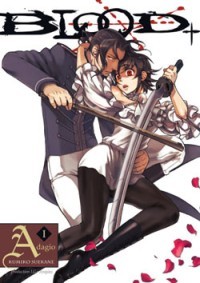
Vol. 1
(by Kumiko Suekane, original concept by Production I.G & Aniplex, Dark Horse, $10.95)
FROM THE BACK COVER:
"In the two-volume Blood+ Adagio manga series, Kumiko Suekane explores the rich Blood+ mythos further—serving up a prequel to the Production I.G/Aniplex anime series and taking us back to one of Saya and Hagi's first missions for the Red Shield. On the eve of the Russian Revolution, our favorite Chiropteran-hunting duo masquerades as members of Tsar Nicholas Romanov's royal chamber orchestra. Saya begins to uncover some of the strange secrets of the Romanov royal family and finds some hideous Chiropteran beasts who are doing a little masquerading of their own! Blood+ Adagio is a unique addition to the Blood+ horror-fantasy universe, and this short series embraces the same mix of action, humor, and horror elements that made the original Blood+ manga series such a bestseller."
EVIDENCE FOR:
No matter what time period a Blood+ spinoff is set in, certain conditions must be met: Saya goes around slicing up Chiropterans with her sword, conspiracies and cover-ups intertwine to keep the audience guessing, and Hagi must play the cello every now and then just for the sake of coolness. The Adagio manga meets all that, then throws on some aristocratic Russian elegance for good measure—making it the perfect blend of period piece and horror action-adventure. A sprinkling of famous historical figures also adds to the intrigue and "what-if" factor: is it any surprise that the Romanov princess Anastasia and mad monk Rasputin are both connected to this conspiracy? And when the time comes for serious Chiropteran-slaying action, this volume delivers the goods, with both Saya and Hagi getting into some serious swordfights and the last chapter ending things on a powerful emotional climax. At the same time, the artwork still makes room for the quieter details, with elaborate period dress and architecture that are sure to please those with an eye for history. For a two-volume series, it looks like the first half is off to a good start.
EVIDENCE AGAINST:
On one hand, it would be silly and wrong-headed to criticize Kumiko Suekane for drawing in her own natural style. On the other hand, her own natural style deviates far enough from the Blood+ anime that it pretty much ruins the tone of the series. This is most evident in the first couple of chapters, which come off as some kind of Russian royal family sitcom where Saya blushes her way through an awkward orchestra rehearsal. (It is hard to imagine the anime version of Saya blushing at anything, except maybe Hagi.) Even Hagi himself loses a certain dimension of coolness and looks almost schlumpy at times—all because of some subtle quirks in the character design. Then again, visuals are more a matter of taste, and ultimately it's the story that really ends up hurting this spinoff. Certain subplots about members of the court orchestra end up as a distraction from the real issue at hand, which is supposed to be Rasputin and the royal family. Forget about Royal Musicians A and B, and focus on the deal with Princess Anastasia and Prince Alexei, and maybe then we'd have a story.
FINAL VERDICT:
The problem is simply this: they made Saya too moe! But the story is still intense and the action genuinely satisfying, so this one gets a B-.
THE LOUDEST WHISPER

Vol. 1
(by Temari Matsumoto, BLU, $12.99)
FROM THE BACK COVER:
"High School students Hiroshi and Seichi are the closest of friends, which only adds fuel to the fire of gossip about their supposed romantic involvement. When quashing the lascivious rumors becomes impossible, will these friends do the opposite and really give everyone something to talk about?!
From the artist of Just My Luck, Shinobu Kokoro, and Kyo Kara Maoh! comes a walk along the fine line that separates friends from something way more!"
EVIDENCE FOR:
To call this volume a collection of "one-shots" or "short stories" is almost too generous—these are more like vignettes, little subunits of story where capturing the emotion of the moment is what matters. To that end, Temari Matsumoto nails it every single time: in just a few short scenes, we get an instant sketch of young men who are thrown hopelessly into a maelstrom of lust. And it's not like the same scenario is repeated over and over: aside from the standard "best friends in high school" relationship, we also get things like a master and butler, or even a pharmacist and patient. Short as these stories may be, it's the rapid emotional turnaround that makes each one so arresting—one moment the guys are too shy to even kiss, and then just pages later they're banging each other's brains out, and getting caught up in that transition is part of each story's excitement. Matsumoto's artwork, with its straightforward sense of line and strong facial expressions, also adds to the immediacy of the moment and the natural flow from one scene to the next.
EVIDENCE AGAINST:
Hey, what are Conrad and Wolfram doing on the cover of this manga? Sure enough, Matsumoto's artistic talent only goes as far as drawing maybe five different character types, all of which show up in this book. But that's not the only recycling going on here. Every single chapter follows the exact same plotline—and once you get to about the fourth story where the climactic scene involves two guys orally pleasuring each other yet again, it stops being emotional or cute or even funny and becomes this pathetic exercise in tedium. At that point it's not even worth feeling aesthetically offended by it. The one thing that is offensive, however, is the sheer improbability of the scenarios that bring the protagonists together. (I'd like to nominate "pharmacist gives patient the wrong medicine" as the stupidest one.) Honestly, what kind of parallel universe are these characters living in where everyday activities suddenly cause them to be overcome by earth-shattering sexual desire? That kind of stuff gets criticized all the time in seinen harem romances, so let's be fair and say it's pretty damn awful when it shows up in BL manga as well.
FINAL VERDICT:
The drawings are pretty, and the emotions run strong, but boy is this is a repetitive pile of C- material.
OH MY GODDESS!
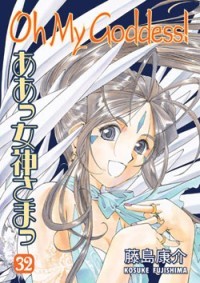
Vol. 32
(by Kosuke Fujishima, Dark Horse, $10.95)
FROM THE BACK COVER:
"With both Peorth and Gate (finally) sent home, Chihiro ends up leading the rest along on a tradition that dates back to the Motor Club—namely, a training retreat that's a thinly disguised excuse for a vacation. And even though Keiichi can barely swim, he's starting to hear the siren song of the sea ... the problem is, it's a real song, sung by a real siren!"
EVIDENCE FOR:
Oh My Goddess bikini times! YES! Let's be perfectly honest here: if you're one of those fans who follows this series mostly for the hot girls, and have been hoping for a chance to see Belldandy, Urd or Skuld (you pervert!) in a swimsuit, then this is the volume for YOU! But eye-catching fanservice isn't the only good thing to come out of this little beach trip; one glance at the artwork shows that the change of surroundings has suddenly given Kosuke Fujishima the ability to draw backgrounds again. Swirling waves and a majestic shoreline set the mood for this story arc, which turns out to be more than meets the eye when Keiichi falls victim to a supernatural mystery. In a series better known for harem comedy and epic magical combat, this kind of quiet drama—the siren song brushing past Keiichi's ears, the moody character of the ocean at night—is a refreshing change from typical Goddess fare. Even the characters they meet are different: after chapters and chapters of goddesses and celestial warriors and gates, this encounter with creatures of the sea is something not easily forgotten.
EVIDENCE AGAINST:
Oh, how cute, they tried to distract us with yet another short story arc that has absolutely no impact on the series at large! After the irritating moe antics of the Gate, it's disappointing to see that Keiichi's seaside vacation turns out to be approximately the same thing but with a different setting and different characters. Simply put, a cute young girl from another world tries to spirit Keiichi away, thus causing Belldandy to panic, after which they resolve the issue by all becoming friends. Come on, think of something different already! The story arc's mindless quality also causes the characters to behave in mindless fashion: there goes Belldandy again with her vapid smiles, Keiichi being a wimpy weed who's magically susceptible to anything, Skuld being the immature brat that she is ... in fact, if this weren't actual content created by the manga-ka, it would be so tempting to call it filler and ask when the real series starts again. At this point, another epic magical battle might not be such a bad idea.
FINAL VERDICT:
Somewhat on the light and inconsequential side, but the striking seaside backgrounds and quiet, mysterious tone of the story still add up to a decent B-.
RALΩGRAD
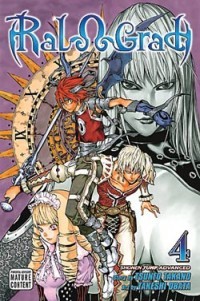
Vol. 4
(by Tsuneo Takano and Takeshi Obata, Viz Media, $7.99)
FROM THE BACK COVER:
"In the midst of a war, a child is born during a bloody battle at the cost of his mother's life. From this baby comes forth a huge and powerful dragon born of Shadow. Within minutes the dragon lays waste to the landscape, but a quick-thinking knight locks the baby in a cage of darkness, where he grows to be a young man, knowing only the kindness of his young female tutor. Until the day the Shadows attack and he is set free...
The final battle for the fate of humanity rests with Ral and his Shadow, Grad. But he must first get past the immortal Red Phoenix, a Shadow with no known weakness, and the fearless Black Rhinoceros before he can take on the Queen of Darkness. With her Clear Human Shadow, Opsquria can kill with just one look! But will Ral have to make the ultimate sacrifice in order to defeat her?!"
EVIDENCE FOR:
The quick answer to that last question: yes, Ral carries out a sacrifice of sorts—but not the kind you might expect. Similarly, when the task falls upon Ral and friends to defeat the Red Phoenix, they discover that there is a way to beat an immortal enemy—just not the the way they might expect. That, in a nutshell, is the ending of RalΩGrad, where surprises abound and the path to victory demands somewhat more finesse than simply smashing the other guy into submission. From an artistic perspective, however, it's clear that smashing the other guy into submission is still the most fun part: Takeshi Obata's illustrations of the Shadows and their monstrous attacks continue to set a new standard when it comes to fantasy art. It takes real skill to transform familiar-sounding creatures—dragon, phoenix, rhinoceros—into beasts from another world, but Obata is just the kind of guy to pull it off, while also infusing each battle with incredible drive and energy. No better way to end a sword-and-sorcery epic than with a bang.
EVIDENCE AGAINST:
That's it? Really? Even though Ral was able to finish the job (as opposed to trotting off with "Our adventure is just beginning!"), one can't help but wonder if Takano and Obata got the dreaded call saying that their series was tanking and that it was time to wrap things up. And who can blame them? The previous volume was already showing signs of dragging, with generic RPG characters, a linear quest pattern, and monsters that just kept getting tougher and more ridiculous. So ridiculous, in fact, that our heroes have to pause and explain each Shadow's special powers every single time. In the middle of a fight. Y'know, nothing kills the thrill of battle faster than having to stop and chat. Seriously guys, less talking, more fighting! Not that the fighting's all that great—the drawings may be pretty, but they don't make a lot of sense, and readers will probably spend just as much time trying to guess who's attacking what as they do admiring Obata's style. So, as the monsters get more ridiculous, so does the artwork. It's probably just as well they stopped when they did, or we'd all have cataracts by Volume 8.
FINAL VERDICT:
It tries to pull off a few more "wow" moments before the end, but turns out to be an overall disappointment. This short-lived dragon tale gets a C.

SKETCHBOOK
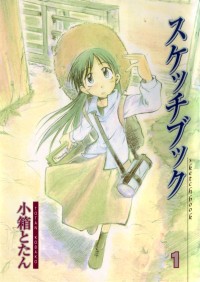
Vol. 1
(by Totan Kobako, Mag Garden, ¥552)
FROM THE ENCYCLOPEDIA:
"Sora Kajiwara is a shy girl who enjoys drawing in her sketchbook. She joins the Art Club at her school, and meets many colorful and eccentric people."
EVIDENCE FOR:
Previously, we discussed how K-ON! pushed the boundaries of the 4-panel strip by stringing the format into complete chapters and story arcs. By comparison, Sketchbook—which predates K-ON! by a few years—proves that there's still plenty of fun to be had simply by honing and refining the art of the one-shot gag. Character and plot take a backseat to the simple foibles of being in the school art club, like the addictive squishyness of kneaded erasers, seeing everything through a 3x3 grid ("It's like I'm a robot!"), and the fact that all the other students there are nuts. Indeed, the series doesn't really start to take off until the entire supporting cast is filled in, with delightful eccentrics like Hazuki (who is so cheap that she tries to glue broken pencil leads back together), or the two airheaded seniors who at one point end up playing shiritori in an endless loop, or even the supervising teacher herself. The laid-back tone and unpretentious art style, which does in fact resemble a sketchbook in its simplicity, also help to keep the series from getting too hyper and irritating (a common problem with comedies like these).
EVIDENCE AGAINST:
Okay, okay, so we're giving this one a free pass on the lack of plot—but that just makes it even more awkward when it does appear to be stringing similarly-themed strips together. Certainly, there's nothing with taking a joke and running with it—like, say, the neighborhood cats, or the difficulty of using oil paints—but when the joke is suddenly dropped in favor of other subject matter, that's when it gets disorienting. More disorientation can be had with the nondescript character designs, which rely mostly on basic hairstyle and facial variations, and after one volume it's still hard to remember anyone past the first few major characters. Lastly, the one big thing that works in the series' favor—its laid-back attitude—also becomes its worst enemy when the strips start gliding along on autopilot without turning out any particularly good jokes. There's a great sense of humor at work here, but it needs to be on 100% for the series to succeed. You can't do a slice-of-life comedy if you forget the comedy part.
FINAL VERDICT:
Rather than trying to forcibly moe you into submission, the jokes seem to rise up effortlessly and make you laugh without even realizing it. Truly, achieving that kind of humor is an art in itself.

Walk into any Japanese bookstore and you'll know there's a whole other universe of manga that's never been published in English. But out of all the "Series I'd Like To See Licensed" reviews that came in (and there were plenty of good ones to pick from!), it was Ben Jonas and his "Series I'd Like To See Pried From ADV Manga's Cold, Dead Hands" that caught my eye. (Come to think of it, I never did rule out titles where the original license had expired, did I?...) Who's going to save this one from the out-of-print pile?
THOSE WHO HUNT ELVES
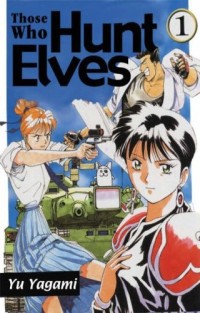
(by Yu Yagami, Media Works, ¥578 ea.)
First released by the now-defunct ADV Manga back in 2003, it was one of many titles to fall under ADV's "Translated-But-Never-Finished" list (which includes Peace Maker Kurogane, Tactics and Aria, all three of which have since been acquired by Tokyopop). The anime that preceded it (when it was released in the U.S. back in 1999 and 2003, respectively) followed the adventures of martial-artist Junpei, actress Airi, gun-toting schoolgirl Ritsuko, and their tank possessed by the spirit of a cat, Mike (pronounced Mi-kay), as they try to return to Japan by uncovering spell fragments scattered all across the land... by stripping elven women. Thanks to Junpei interrupting elf priestess Celcia's incantation that would've brought everyone back home safe and sane, the text of the spell book exploded, leaving parts and pieces of the incantation tattooed onto the bodies of female elves all over the land. And thus begins Those Who Hunt Elves, as our heroes must traverse a land unlike their own, stripping elves left and right until they're able to find each and every last spell fragment (much to the lamentations of Celcia, who not only constantly bickers with Junpei, but is also stuck in the form of a dog, then a panda).
While the anime itself is pretty wacky, the manga goes one step further, introducing new challenges and foes not seen in the anime (such as the Elf Hunters having to take on a elf sorceress bent on world domination). Throw in Yu Yagami's twisted take on fairy tales and legends both Western and Eastern (as well as his obsession with Virtua Fighter), and you've got the makings of a sleeper hit (like Dokkoida?! and Hikkatsu!, two of his other titles that have been translated and completed). ADV Manga put Those Who Hunt Elves on hiatus after volume 7 was released in late 2004, and since then, the series has been gathering cobwebs. One possible reason why ADV couldn't commit to finishing the series (aside from low sales and the complete inability to release anything past 11 volumes) was the length of the series (21 volumes, not counting the recently-released in Japan Those Who Hunt Elves Return one-volume sequel). Times may be tough, but if someone's willing to take on such a monumental task (Yen Press, I'm looking at your direction), I'd snatch up every volume in a heartbeat.
Is there a hidden gem of manga you'd like to reveal to the world? Is there a piece of garbage that deserves to be bashed in public? Or is there a title that didn't get a fair grade here, and you want to set the record straight?
Now's YOUR chance to be the reviewer! Write a review of about 300-400 words (a little more or less is fine) and include:
- Your name
- Title of manga (and volume no., if applicable)
- Author/Artist
- Publisher
- Briefly describe the story, then explain why this manga is great, terrible, or in between. Be objective, but also be entertaining.
Then send it in to rtoreaders (at) gmail (dot) com (plain text format preferred). One review will be selected out of all the submissions and will be published in the next column. All types of manga and manga-inspired comickry are accepted, from past and present, from Japan and beyond—what matters is that it's the Reader's Choice! NOTE: Submissions may be edited for formatting and grammar.
discuss this in the forum (7 posts) |